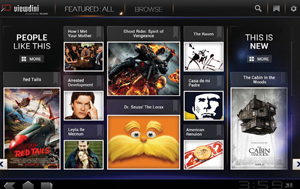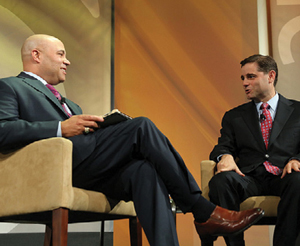Cable Touts ‘Viewdini,’ Wi-Fi

Gary Arlen BOSTON—“Coopetition” among big cable multisystem operators (MSOs) and between the MSOs and Verizon Wireless took on new dimensions during The Cable Show last month.
More significantly, these cooperative/ competitive deals for mobile and wireless video services pose major implications in the ongoing spectrum battle for airwaves and for viewers’ attention.
Verizon’s video search service “Viewdini,” which the company opted to unveil at the Cable Show, consortium of large MSOs, pave the way for more viewing on mobile handsets and tablets, potentially drawing eyeballs away from mobile digital television (mDTV) broadcasting.
Viewdini is a mobile video portal that will aggregate and deliver mobile content including Netflix, Hulu, mSpot (a Samsung cloud-based media content provider), plus movie and TV sites to Android devices. It will be available on 4G LTE (“Long Term Evolution” format) handsets, said Verizon Wireless President/CEO Dan Mead.
Viewdini will offer content from cable networks as well as shows that are available via Verizon’s FiOS TV service, allowing customers to search for, and watch content from services to which they subscribe. The Android app will be free, but wireless customers will pay for usage fees for downloads based on their Verizon Wireless data allowance.
“We saw the capacity of the LTE network,” Mead said. “We saw the hunger of consumers to get this [content] whenever they wanted on whatever device they have.”
CABLE WI-FI
Separately, five of the biggest MSOs—Comcast, Time Warner Cable, Cox, Cablevision Systems and BrightHouse Networks—are launching a collaborative Wi-Fi system that will eventually have 50,000 hotspots, covering much of America’s biggest cities. Cable Wi-Fi will allow authenticated customers of any participating MSO to use the Wi-Fi facilities of the cable company outside the home.
Citing the “profound implications” of this nationwide cable wireless service, Craig Moffett, telecommunications analyst at Sanford C. Bernstein & Co., said, “The unique usage characteristics of wireless networks leave the door open for a potentially very disruptive Wi-Fi first service.”

The Cable Show's "App Pond" at Imagine Park offered a live showcase for newly developed applications playing over tablets, smartphones and other connected devices. More than 38 million high-speed data cable customers will be able to use the service, according to a Wells Fargo Securities analysis. The first markets to get Cable Wi-Fi service are New York City (and surrounding tri-state area), Los Angeles, Philadelphia and Tampa and Orlando, Fla.
The Cable Wi-Fi system will, among other things, enable cable subscribers to watch streamed TV shows and movies via Wi-Fi (thus not incurring network data charges) when they are away from home—a competitive feature versus Verizon’s 4G vision.
Offering Cable Wi-Fi service for subscribers outside the home might be more appealing than trying to find a local broadcast channel if a viewer’s handset or tablet actually has an mDTV tuner/receiver.
Some analysts see Verizon’s Viewdini offering as a next-generation successor to its VCAST service, using the greater bandwidth capacity of its 4G network. At the same time, the Viewdini deal brings Verizon Wireless closer to the cable TV infrastructure, especially on the programming side.
Verizon already has an MSO connection through its pending acquisition of the airwaves of SpectrumCo, the consortium of big cable TV operators. Long before that deal took shape, Verizon made clear its major plans for mobile video services coming this year.
These alliances, not surprisingly, won the support of FCC Chairman Julius Genachowski. During an on-stage interview with his predecessor and current NCTA President/CEO Michael Powell, Genachowski commended the industry:

Verizon's Viewdini App “Cable has been leading the way in innovating around Wi-Fi,” Genachowski said, who also commended the industry for helping to relieve the spectrum crunch.
WIRELESS AND CROSS-OVER AGENDA
The wireless and cross-over agenda at The Cable Show took many forms. Comcast announced X1, a cloud-enabled TV platform targeted to multiplatform “integrated entertainment experiences,” as the company describes it. The X1 platform uses IP technology to deliver interactivity, custom apps and social media features with Comcast’s traditional video services.
Comcast also introduced “multiscreen telephony,” as some analysts characterized the new “Voice2go”service. Comcast’s plan is to move home phone service onto devices more commonly associated with multiscreen video, such as PCs, tablets, laptops, and smartphones. Among the bandwidth-related features: “Voice2go” would offload cellphone traffic to Wi-Fi networks and enable free calling.

Michael Powell (L), President and CEO of the National Cable & Telecommunications Association, and Federal Communications Commission Chairman Julius Genachowski Separately from Verizon Wireless’s Viewdini service, Comcast introduced the “Xfinity TV Android experience” via a new Xfinity TV Player app—part of the move toward IP television from the MSOs.
The app brings 10,000 hours of the on-demand video-streaming content to Xfinity TV digital customers with Android devices (Versions 2.3/Gingerbread and above); customers will be able to watch video on smartphones and tablets using 3G, 4G or Wi-Fi connection.
This growing collection of competitive/ collaborative ventures plus the accelerating attention to wireless service, even among the traditionally tethered MSOs, indicate increased bandwidth battles. They also augur consumer confusion as viewers must choose which screens and which providers to patronize.
It looks like “wireless + cable,” but it’s still all about the bandwidth and who controls it.
Gary Arlen is president of Arlen Communications LLC, a media/telcom research firm. He can be reached atGaryArlen@columnist.com.
Get the TV Tech Newsletter
The professional video industry's #1 source for news, trends and product and tech information. Sign up below.
Gary Arlen, a contributor to Broadcasting & Cable, NextTV and TV Tech, is known for his visionary insights into the convergence of media + telecom + content + technology. His perspectives on public/tech policy, marketing and audience measurement have added to the value of his research and analyses of emerging interactive and broadband services. Gary was founder/editor/publisher of Interactivity Report, TeleServices Report and other influential newsletters; he was the long-time “curmudgeon” columnist for Multichannel News as well as a regular contributor to AdMap, Washington Technology and Telecommunications Reports; Gary writes regularly about trends and media/marketing for the Consumer Technology Association's i3 magazine plus several blogs.

